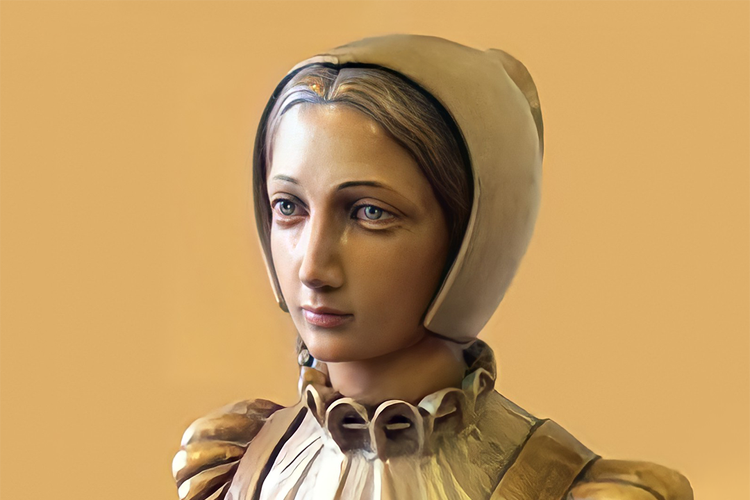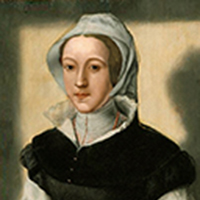
St. Anne Line was a convert, wife and widow, and a martyr of Elizabethan Protestant England. She was born Alice Heigham c.1563 at Dunmow, Essex, England. Her father, Willaim Heigham, was a Calvinist landowner and was the son of one of King Henry VIII’s Protestant “reformers”. In her late teens, she converted to the Catholic Church with her brother, William. The pair were joined in converting by a young man named Roger Line. When their father learned of their conversion, they were both disinherited, with Alice, now known as Anne, losing her dowry. Roger was also disowned by his father upon his conversion.
MARRIAGE AND WIDOWHOOD
In February of 1583, Anne and Roger wed. At an unknown date, William and Roger were both arrested while at Mass and were sent to prison and fined for the crime of attending a Catholic Mass. William was released on a bond system known as surety. Roger Line was exiled to Flanders. He remained there, and received a small stipend from King Philip II of Spain, who became aware of his plight. He sent funds regularly back to Anne in England so that her needs would be met. He died in Flanders in 1594.
After her husband’s death and having been cut off from her family, Anne had no source of income to support herself. This was complicated by her being in ill health. She began providing refuge in her home for priests, who were hunted down as if they were criminals. Catholic priests at that time in England who chose to remain to serve their flock knew that they faced a death sentence if they were caught. At about this time, a Jesuit priest named John Gerard was made aware of Anne’s situation. Knowing that there were a number of Catholic priests in grave danger, he set up a house in London for them to live in hiding, and asked Anne to manage the home. Father Gerard was arrested and tortured in order to obtain information about underground priests, but he of course, refused to betray his brethren. He managed a daring nocturnal escape from the Tower of London, and Mrs. Line then moved on from the house. She did this primarily because as time went on, knowledge of her refuge became more widespread. She rented several apartments and continued her work providing shelter for priests. Over the years, she endured a number of raids, where the priests could escape to cleverly hidden “priest holes” behind walls, stairwells, and attics.
PROTECTOR OF PRIESTS TO THE END

On February 2, 1601, the Mass of The Purification of the Virgin Mary was about to be offered in Anne’s home. This feast is now known as the Presentation of the Lord or Candlemas. This feast dates back to at least the fourth century and takes place forty days after Christmas, commemorating the day that Mary and Joseph presented the infant Jesus at the Jerusalem Temple. Also known as Candlemas, on this feast Christians would bring their candles to be used for the upcoming year to be blessed. At this particular Mass, more people than usual attended due to the feast, and the light of the candles aroused suspicion. The home was raided by constables, but not before Father Francis Page was able to hide safely away. Anne Line and two other laypeople were arrested. Anne was sent to London’s Newgate Prison, locked away with rapists, murderers, and thieves. On February 26, seriously ill with a fever, Anne was brought to trial while carried in a chair, too weak to walk. Incredibly, she told the court that she did not regret protecting priests, but only regretted that she was not able to protect a thousand more. She was sentenced to death for helping a Catholic priest. She was brought to the gallows at Tyburn the following day with her confessor, Father Roger Filcock, and [Bl.] Father Mark Barkworth. Both priests were tortured by drawing and quartering before they were hanged. Anne was the first to die, but not before repeating that she wished she could have protected even more priests. When the two priests were led by her dead body, Father Barkworth paused to kiss her hand stating, “Oh, Mrs. Line, who has now happily received your reward! You are gone before us, but we shall quickly follow you to bliss, if it please the Almighty.” Anne Line was approximately thirty- eight years old at the time of her death.
St. Anne Line’s brave fidelity to the Catholic Faith is as striking as the renowned women and girls martyred during the years of Roman persecution in the early Church. She was fearless in the face of known grave danger. She was beatified in 1929 and canonized in 1970, one of the Forty Martyrs of England and Wales. With these other martyrs, her feast day is May 4. She is a patron for widows and converts to Catholicism.
